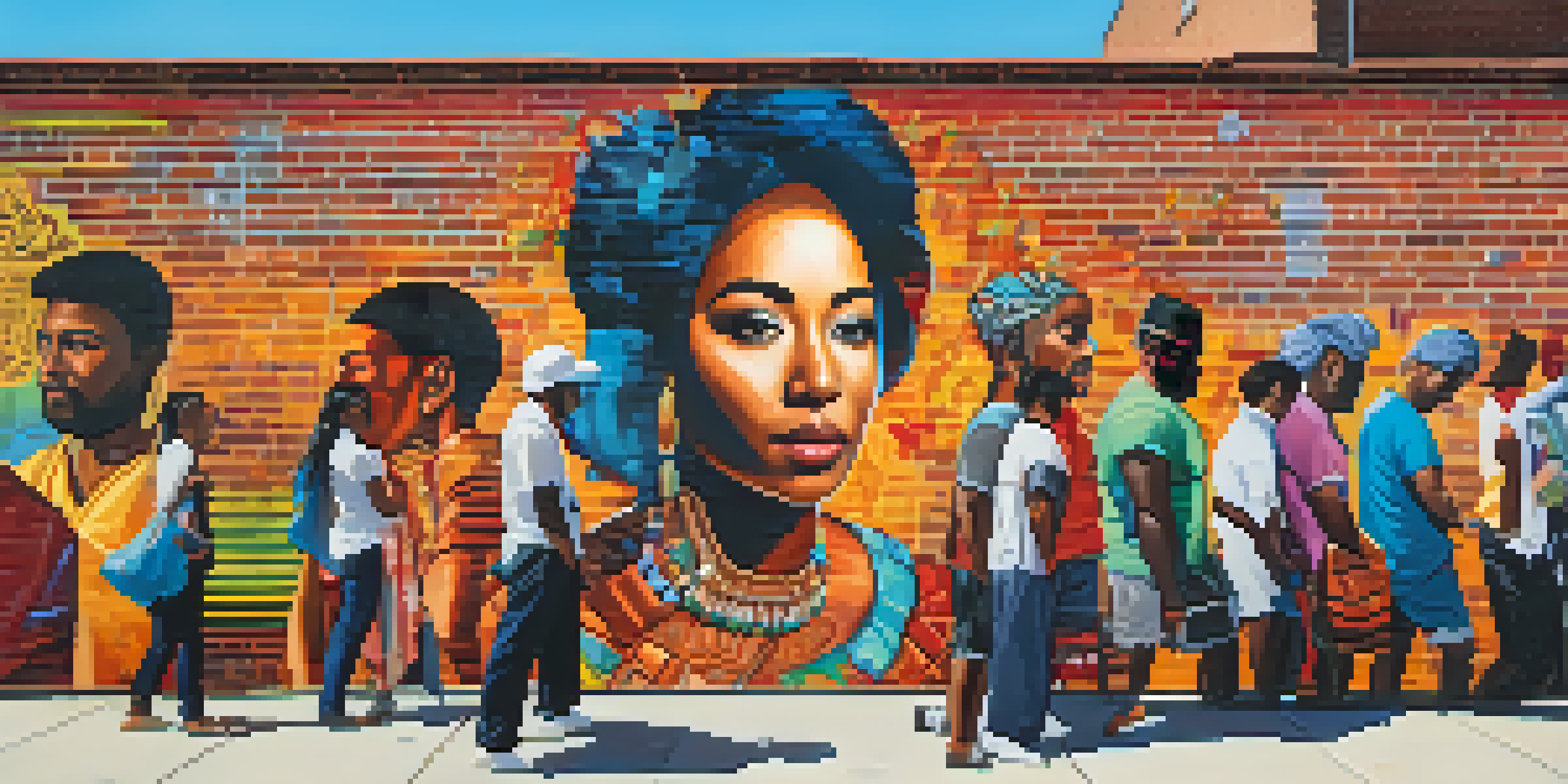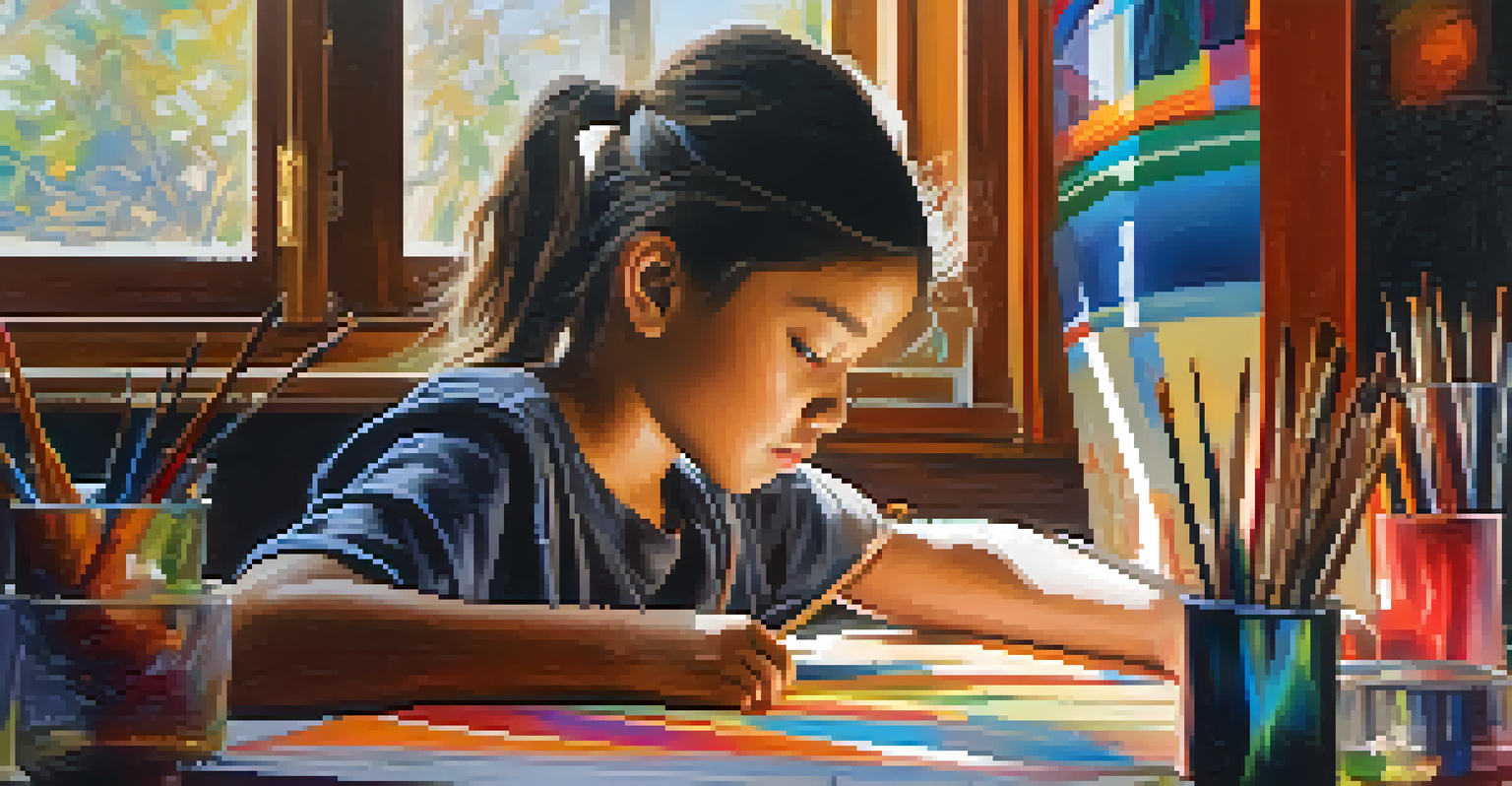The Role of Visual Arts in Promoting Cultural Understanding

Visual Arts: A Universal Language for All Cultures
Visual arts transcend spoken language, acting as a universal medium for expression. Through colors, shapes, and forms, artists convey emotions and stories that resonate across cultural boundaries. When we observe a painting or a sculpture, we often find reflections of our own experiences, even if the artist comes from a vastly different background.
Art is the most beautiful of all lies.
For instance, consider the powerful impact of street art in urban areas. These murals often address social issues that affect people globally, making them relatable regardless of cultural context. By engaging with these artworks, individuals can gain insights into the lives and struggles of others, fostering a sense of connection and understanding.
As we delve into the world of visual arts, we uncover narratives that might otherwise remain hidden. This shared experience of art creates opportunities for dialogue, allowing diverse perspectives to emerge and enriching our cultural tapestry.
Art Exhibitions: A Platform for Cultural Exchange
Art exhibitions serve as powerful platforms for cultural exchange, bringing together works from various traditions and backgrounds. These events not only showcase the creativity of artists but also invite viewers to engage with different cultural narratives. When we walk through an exhibition hall, we are often transported into the heart of another culture, experiencing its beauty and complexities.

For example, international art fairs highlight artists from all over the world, allowing attendees to appreciate a wide range of artistic expressions. By encouraging conversations between artists and audiences, these exhibitions foster deeper cultural understanding and appreciation. They also spark curiosity, prompting visitors to learn more about the cultural contexts behind the artworks.
Art as a Universal Connector
Visual arts transcend language, fostering emotional connections and understanding across diverse cultures.
Moreover, such events often include workshops and talks, providing further opportunities for interaction and education. By participating actively, attendees can break down stereotypes and misconceptions, paving the way for a more inclusive cultural dialogue.
Storytelling Through Visual Arts: Bridging Differences
Visual arts often tell stories that reflect the unique experiences of different cultures. Through techniques such as photography, painting, or film, artists narrate personal and collective histories, helping audiences understand the values and traditions of others. These narratives can evoke empathy and challenge preconceived notions, ultimately bridging cultural divides.
Every artist dips his brush in his own soul, and paints his own nature into his pictures.
Take, for example, a documentary film that explores the lives of indigenous communities. Such films can illuminate the challenges and triumphs faced by these groups, giving viewers a glimpse into their world. This storytelling approach invites audiences to engage with unfamiliar cultures on a deeper level, fostering appreciation and respect.
By presenting these narratives visually, artists create a lasting impact that words alone may struggle to achieve. This form of storytelling can inspire action and advocacy, encouraging viewers to support cultural preservation and understanding.
The Role of Technology in Visual Arts and Cultural Outreach
In today's digital age, technology plays a crucial role in promoting cultural understanding through visual arts. Online platforms and social media have made it easier for artists to share their work globally, allowing diverse cultures to connect and learn from one another. This accessibility breaks down barriers that once limited exposure to different artistic expressions.
For instance, virtual art galleries and online exhibitions enable audiences from around the world to explore artworks without geographical constraints. Viewers can appreciate pieces from various cultures, all from the comfort of their homes. This democratization of art fosters a wider appreciation and understanding of cultural diversity.
Education Enhances Cultural Awareness
Art education encourages exploration of global traditions, cultivating empathy and respect among students.
Additionally, digital storytelling tools allow artists to present their work with context, providing insights into cultural significance and history. By combining art with technology, we create new avenues for dialogue and collaboration, reinforcing the importance of cultural understanding.
Education: The Foundation of Cultural Appreciation Through Art
Education plays a vital role in fostering cultural appreciation through visual arts. Art programs in schools and communities often expose students to diverse artistic traditions, encouraging them to explore and understand different cultures. This exposure lays the groundwork for empathy and respect as students learn about the stories behind various art forms.
For example, incorporating lessons on global art history can help students appreciate the cultural contexts of famous works. By analyzing pieces from various cultures, students can draw connections to their own lives and communities. This understanding cultivates a sense of responsibility in how they approach and engage with different cultures.
Moreover, hands-on art projects that celebrate cultural diversity can further enhance this learning experience. By creating art inspired by various traditions, students not only develop their artistic skills but also gain a deeper understanding of the values and beliefs that shape different cultures.
Community Engagement: Art as a Catalyst for Unity
Community engagement through visual arts can serve as a catalyst for unity and cultural understanding. Art initiatives that bring together individuals from diverse backgrounds foster collaboration and dialogue. These communal projects often highlight shared experiences, helping participants recognize their common humanity.
For instance, community mural projects can involve artists and residents working together to create a public piece of art. This collaboration not only beautifies the neighborhood but also allows participants to share their stories and perspectives. The resulting mural becomes a symbol of collective identity and understanding.
Community Engagement through Art
Collaborative art initiatives unite individuals from various backgrounds, promoting dialogue and shared identity.
Additionally, art festivals that celebrate cultural diversity can attract individuals from various backgrounds, creating spaces for interaction and learning. These events help break down barriers and build relationships, reinforcing the idea that art can be a unifying force in our communities.
Challenges and Opportunities in Promoting Cultural Understanding
While visual arts hold great potential for promoting cultural understanding, challenges remain. Issues such as cultural appropriation, where elements of one culture are used without understanding or respect, can hinder genuine appreciation. It's essential for artists and audiences alike to navigate these complexities thoughtfully and responsibly.
However, these challenges also present opportunities for dialogue and education. By engaging in conversations about cultural sensitivity and respect, we can foster a more inclusive art community. This awareness encourages artists to approach their work with intention, ensuring that they honor the cultures they represent.

Ultimately, addressing these challenges head-on can lead to richer artistic expressions and a deeper understanding of cultural diversity. By embracing both the obstacles and opportunities, we can create a more harmonious and empathetic world through the lens of visual arts.
Conclusion: The Lasting Impact of Visual Arts on Cultural Understanding
In conclusion, visual arts play a significant role in promoting cultural understanding by bridging gaps and fostering empathy. Through storytelling, community engagement, and educational opportunities, art can challenge stereotypes and encourage dialogue. As we navigate our increasingly globalized world, embracing the power of visual arts is more important than ever.
By recognizing the universal language of art, we open ourselves to the richness of diverse cultures. Each artwork has the potential to convey unique stories, inviting us to learn and grow. As we engage with these narratives, we cultivate a deeper appreciation for the beautiful tapestry of human experience.
Ultimately, visual arts inspire us to connect, reflect, and act towards a more inclusive and understanding society. Let's continue to explore and celebrate the transformative potential of art in our lives, as it has the power to unite us all.